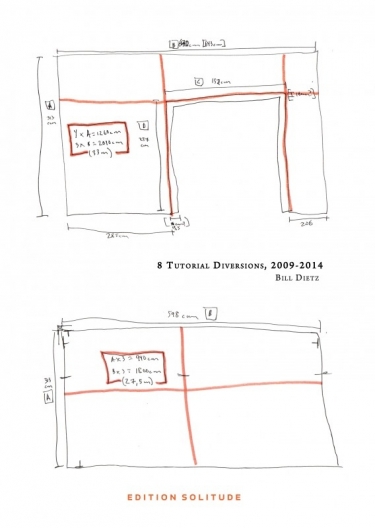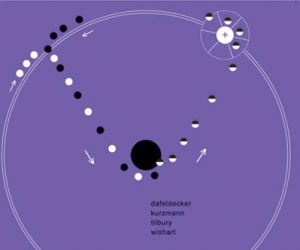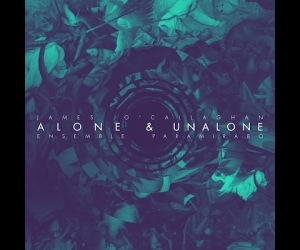Edition Solitude publishes the work of resident artists at Akademie Schloss Solitude, an artist fellowship and residency program in Germany. One of its recent monographs is 8 Tutorial Diversions, 2009-2014 by American-born, Berlin-based artist and composer Bill Dietz. Consisting of eight scores from his “Tutorial Diversions” series, each work is a “composed listening” designed to be performed by listeners themselves in domestic settings. The scores are illustrated by a series of beautiful photographs and accompanied by specially written “softwares” that facilitate their performance. The softwares create alterations—or “profiling” as Dietz calls it—of any given audio source supplied by the listener, the output of which becomes the material heard in performance—a performance that the listener enacts. With each score, the listener (sometimes referred to as the “user”) is required to set up a specific loudspeaker orientation in relation to themselves and their present environment before following instructions to physically move in relation to their subjective reception of the audio during playback. For example, the piece “3 Part Dances” instructs the listener to adjust to the volume of the audio by moving their body in relation the sound source, an act that eventually takes them out of their home and onto the street, even as the volume level steadily increases. The works wonderfully traverse the border of private and public, performer and audience, through their enactments. Whether alone or in group situations, the experiences produced by these works are untimely and beautiful recognitions of the always already-social nature of sound.
Bill Dietz studied composition at the New England Conservatory (Boston) and Cultural Studies at the University of Minnesota (Minneapolis). He has been based in Berlin since 2003, where he has worked with, among others, Peter Ablinger, Christian von Borries, Catherine Christer Hennix, Chris Newman, and Maryanne Amacher. In 2012 he was appointed cochair of the music–sound department in the Milton Avery Graduate School of the Arts at Bard College (Annandale-on-Hudson, N.Y.). Bill Dietz’s recent work is primarily concerned with the performance of listening. This interest has been developed across a variety of subjects and contexts in his work: formal compositions considering the private interpretive act of the musician, interventions into the concert as a performative situation, and the instrumentalizing of an entire Le Corbusier building (Unité d’habitation) for his recent sound work, “LET THE USER SPEAK NEXT / LA PAROLE EST AUX USAGERS.”
Dietz’ introductory essay to 8 Tutorial Diversions, 2009–2014, entitled “Franz Schubert, Patsy Cline, the Avant-Garde,” charts the development of the “Tutorial Diversions” series in relation to Dietz’s articulating of a post-Cage experimental music history concerning the unbinding of compositional acts from traditional notions of “material,” instead emphasizing the production of certain “modes of attention” as material in and of themselves. In the text, Dietz specifically cites American composer and artist Maryanne Amacher as a major influence on his thinking, pointing out that her work addresses the complication of perception itself as a compositional process.
The monograph explores listening as a set of choreographic tools that enact a compositional relationship between the listener and the present conditions of common listening practices. The works forgo a specificity of audio materials in order to foreground receptivity as both form and subject. As Dietz writes, “the conditions of listening themselves become the immediate subject of the experience.” In doing so, the works produce all sorts of interesting proximities between ourselves, others, and environments by calling for an active and continual reorienting of the listener according to their apprehension. Listening, then, becomes a social dance, partnering with a renewed corporeal presence of music.
With much humility and intelligence, the book and the works themselves ponder what is left for the listener in an era in which it sometimes feels like everything has already been heard. “Tutorial Diversions” offer a turning of our receptivity—a reorientation of listening back towards you, not in relation to known audio objects or a “mode of attention,” but towards the constant strangeness of an echoing indeterminate you.



